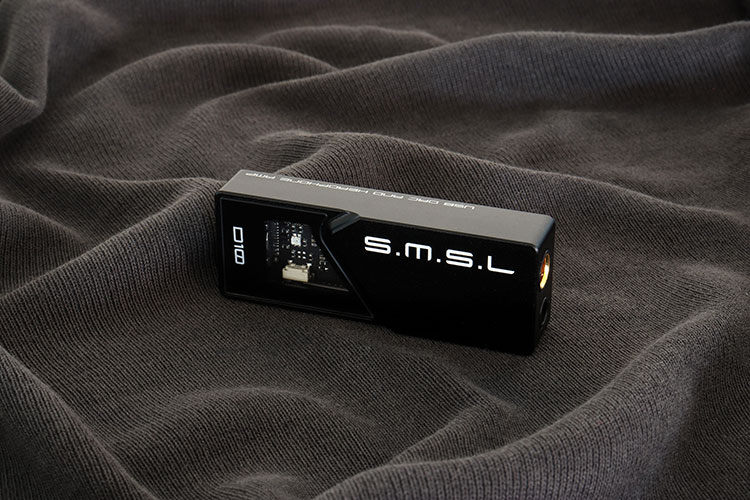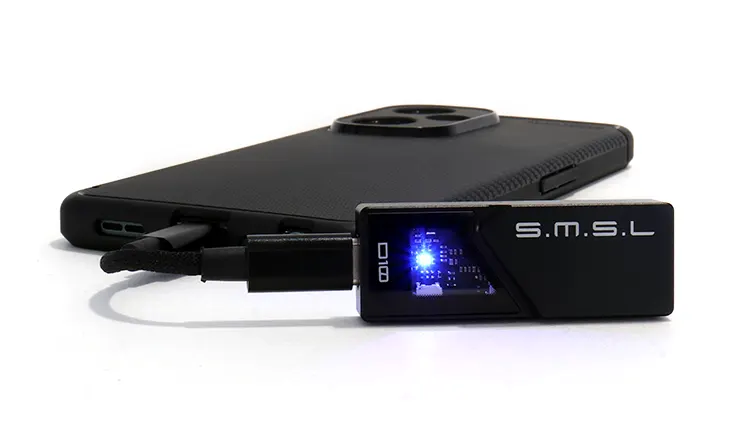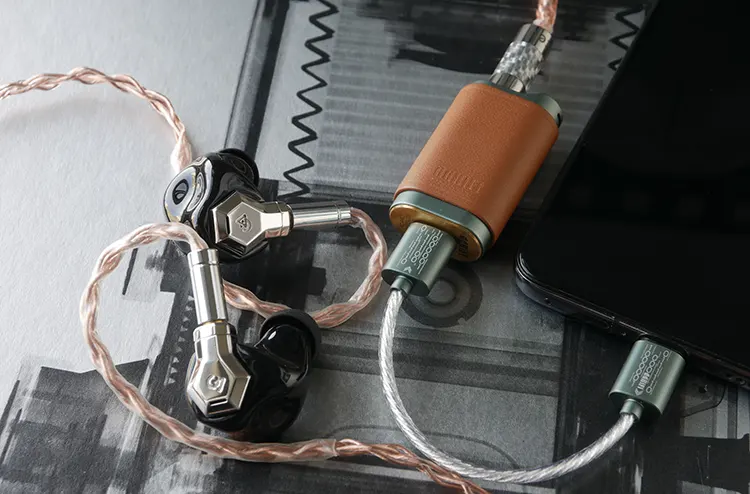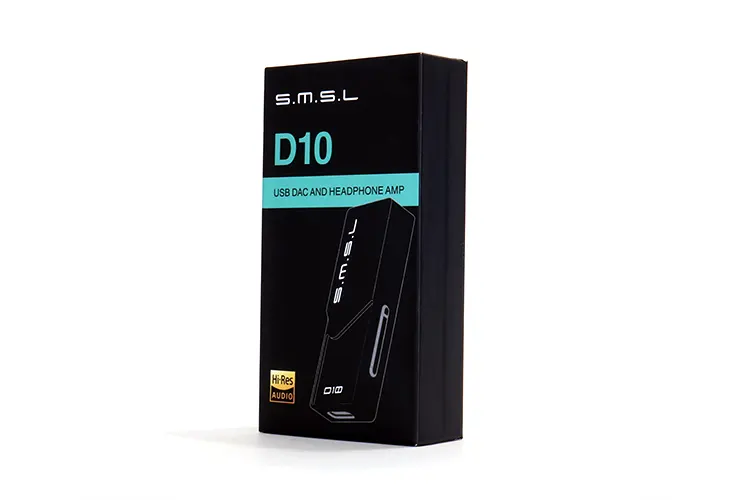Synergy
Battery Drain
The SMSL D10 is a device that doesn’t run hot, it runs lukewarm. I never felt excessive heat from this device and that means it’s quite efficient.
On average, I was able to get four minutes of playback time off my mobile device for every single percentage of battery drain. My smartphone battery is 5000mAh which is an average-sized battery.
Power
What surprised me the most about the SMSL D10 was the amount of power on tap that it has, especially on the balanced side. It doesn’t have a gain switch so you have to use good volume control practices, especially if you’re using sensitive IEMs.
All I can say is make sure the volume is low before you commit because, on my first attempt at using this device, I didn’t practice what I preach and received quite a scare.
There are some small annoyances on the first track of any playback session. The D10 seems to come in late and miss the first second of tracks as the auto-off feature is disengaged. I wished there was a way of adjusting that but as stated, there’s no app available for this device.
Pairings
Although the SMSL D10 doesn’t have a gain control, it manages to pair well with sensitive IEMs and strikes a balance between power and delicacy. The volume acting as a separate entity helps.
But I would look into a warm-sounding set because of its bright character. IEMs like the ORIVETI OH700VB that with the flick of a switch, you can adjust on the fly and choose the warmest setting. This dongle seems to play well with single dynamic driver IEMs.
FiiO also has a stack of readily available IEMs that have user-tuning features that can adapt to the D10 sound signature. For example, the FD5 has swappable output nozzle filters.
Even the recently released ORIVETI OD200 and other dynamic driver IEMs would surely benefit from the bright tuning due to their limited high-frequency extension.
Select Comparisons
FiiO KA13
Technical
The FiiO KA13 is extremely similar to the D10 in many ways starting with the dual CS43131 DAC setup. This is another dongle DAC that uses dual-mono topology at a bargain price.
It also shares a similar dual amplifier chipset consisting of a pair of SGM8262 amplifiers that are capable of a similar output of the D10, 550mW to be exact, versus the posted 500mW for the D10.
The D10 uses the same I/O which consists of a 4.4mm alongside a 3.5mm, and a USB-C input. The difference here when it comes to features is that the FiiO KA13 has an additional onboard switch labeled D mode, which is just a relabeled gain switch.
You do get other features with the KA13 as well like a full-featured app but neither component is MQA-ready. Both these devices are similar when it comes to digital format capabilities.
For some reason, and one of my complaints here is that the app blocks the section where you can obtain a firmware upgrade when you use the KA13 and other features but to be fair, SMSL rarely offers firmware updates.
Design
The FiiO KA13 is larger but not by much, we’re talking a couple of millimeters here. The KA13 weight also seems close and if there’s a difference, it must be a couple of grams at most. If you look at the specs, my on-hand feel is correct.
You can also turn off and on the digital format indicator LED. In a dark room, one would appreciate that feature. FiiO fortunately uses an LED that is not too bright but the D10’s LED is and there are two of them.
All the dongles in this comparison have some sort of LED but none have two like the SMSL D10 which has one on each side and that could potentially light up a dark room.
Performance
These two dongles perform at an almost identical level sonically and have the same amount of drivability. But what pushes the KA13 forward are the features.
One thing is that the KA13 has the smallest soundstage but it accurately places elements nonetheless and it also has the most forward and focused soundstage.
The gain switch, although not needed much is a welcomed feature and on top of that, the app gives access to some digital filters that give the user a minimum amount of sonic tweaking capability.
ddHiFi TC44C
Technical
Since we’re looking at dongle DACs that use the Cirrus Logic CS43131, ddHiFi’s TC44C uses the same configuration but in a more upscale package. Similar to the D10, the TC44C sticks within the PCM and DSD digital realm and is not MQA-capable.
The TC44C uses the same connectivity, the 4.4mm, a 3.5mm, and a USB-C input. There are no onboard features and the TC44C doesn’t come with an app either.
Even though the TC44C has a nice accessories package, I would consider it the most simple device within this comparison and the dongle DAC market.
Design
ddHiFi managed to fit the same amount of hardware into a smaller package by using separate power circuitry boards and audio circuitry boards, sandwiched inside the shell and linked together by OCC copper connection lines.
ddHiFi also managed to incorporate a Lanyard slot on top of the body but that addition could become an obstacle if you plan on using a 3.5mm connector with a thicker-than-normal plug. The 4.4mm balanced connector does not suffer the same issue.
ddHiFi also includes a leather case for the TC44C inside the box which is a nice touch. I presume the additional accessories and design implementations are some of the factors for the higher price of the TC44C.
Performance
The S10 is more powerful since I can obtain the same volume levels with a reduction of 10 decibels, 57 versus 67 on the volume control, using the same headphones and cables.
The bass has more presence on the TC44C. It seems ddHiFi lowballs their power output numbers and the TC44C seems to have more power on tap than the company specifies. Although its power output rating is lower, it seems more capable in the bass area.
The TC44C might even edge out the competition in this comparison in micro-detail production. But you do pay at the pump as they say. The TC44C requires a larger monetary commitment to obtain. Meantime, the SMSL D10 is obtainable at half the cost.
My Verdict
The SMSL D10 is an attractive offering from SMSL that caters to those looking for a simple and versatile Dongle DAC. It will work in practically any scenario and improve sound quality tenfold over the stock sound of most compatible smartphones and iPhones.
It certainly checks two of the three checkmarks mentioned above. The D10 sounds good, and it’s also a great value. It won’t score any uniqueness points but it won’t break the bank either and still do a formidable job at producing astonishingly good audio.
The SMSL D10 is surprisingly good for the small investment commitment and it even comes in two colors, grey and black. This is what I call a high “bang-for-the-buck” dongle DAC any way you look at it and an excellent first go at this segment from SMSL.
SMSL D10 Technical Specifications
- Input: USB-C
- Output: 3.5mm +4.4mm balanced
- USB compatibility: Windows 7/8/8.1/10/11, MAC OS 6+, Linux, Android, iOS
- Maximum output level: 2Vrms
- Headphone output: 500mW @ 16Ω/ 500mW@ 32Ω/ 160mW @ 150Ω/ 80mW @300Ω/ 40mW @ 600Ω
- THD+ N: 0.00015% (116db)
- Dynamic range: 121db
- SNR: 121db
- Sampling rate: PCM 44.1 ~ 384kHz / DSD 2.8224 ~ 11.2896mHz
- Bit depth: 1bit, 24 ~ 32bit
- Power: 5V/ 200mA
- Size: 55 x 11 x 20mm (WxHxD)
- Weight: 17.5g





